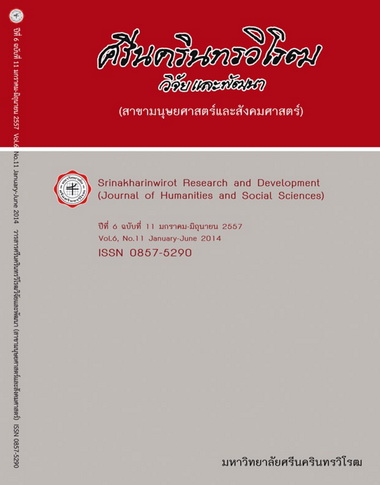การพัฒนาวิธีการสอนของครูโดยความร่วมมือกันจัดการเรียนการสอน แบบบูรณาการ เรื่องเพศศึกษาและโรคเอดส์ในโรงเรียนมัธยมศึกษา ภาคตะวันออกเฉียงเหนือ DEVELOPMENT OF INTERGRATIVE COOOPERATIVE TEACHING ON SEX EDUCATION AND AIDS IN SECONDARY SCHOOLS IN NORTHEASTERN REG
Keywords:
Development of Teaching, Integrative Cooperative TeachingAbstract
บทคัดย่อ
การวิจัยครั้งนี้มีวัตถุประสงค์เพื่อพัฒนาวิธีการร่วมมือกันจัดการเรียนการสอนแบบบูรณาการ
เรื่องเพศศึกษาและโรคเอดส์ในโรงเรียนมัธยมศึกษา เพื่อพัฒนาการสอนของครูโดยการร่วมมือกันจัด การเรียนการสอนแบบบูรณาการเรื่องเพศศึกษาและโรคเอดส์ในโรงเรียนมัธยมศึกษา และเพื่อศึกษาบริบทของโรงเรียนมัธยมศึกษาที่เอื้อต่อการร่วมมือกันจัดการเรียนการสอนแบบบูรณาการเรื่องเพศศึกษาและโรคเอดส์ ภาคตะวันออกเฉียงเหนือ
การวิจัยแบ่งเป็น 3 ระยะ คือ 1) ศึกษาสภาพปัจจุบันและร่างต้นแบบการจัดการเรียนรู้
เพื่อพัฒนาวิธีการร่วมมือกันจัดการเรียนการสอนแบบบูรณาการ เรื่องเพศศึกษาและโรคเอดส์ในโรงเรียนมัธยมศึกษา 2) ศึกษาความเป็นไปได้ของรูปแบบการสอนของครู โดยการวิจัยปฏิบัติการ และ 3) ศึกษาและขยายผลของรูปแบบการจัดการเรียนรู้ ใช้รูปแบบการวิจัยแบบกึ่งทดลอง กลุ่มเป้าหมายในการวิจัย ได้แก่ (1) กลุ่มเป้าหมายในการศึกษาสภาพปัจจุบันในการจัดการเรียนรู้เป็นครู 3 คน และนักเรียน 120 คน โดยการเลือกแบบเจาะจง (2) กลุ่มเป้าหมายในการวิจัยเชิงปฏิบัติการเป็นครู 35 คน โดยเลือกแบบเจาะจง (3) กลุ่มเป้าหมายในการขยายผลการใช้รูปแบบ เป็นครู 600 คน โดยการเลือกแบบเจาะจง
เครื่องมือที่ใช้ในการวิจัยประกอบด้วย 1) เครื่องมือในการศึกษาสภาพปัจจุบัน ได้แก่ แบบสัมภาษณ์และแบบบันทึกพฤติกรรมการจัดการเรียนรู้ 2) เครื่องมือในการวิจัยเชิงปฏิบัติการ ได้แก่ แบบบันทึกการสอน แบบสังเกตการจัดการเรียนการสอน แบบประเมินกระบวนการเรียนรู้ระหว่างครูกับนักเรียนและแบบทดสอบผลสัมฤทธิ์ทางการเรียน 3) เครื่องมือในการขยายผลการใช้รูปแบบ ได้แก่ แบบสอบถามและแบบสัมภาษณ์ การวิเคราะห์ข้อมูลเชิงปริมาณโดยสถิติเชิงพรรณนา ได้แก่ ร้อยละ ค่าเฉลี่ย ส่วนเบี่ยงเบนมาตรฐาน การทดสอบค่าที และวิเคราะห์ข้ข้อมูลเชิงคุณภาพโดยการวิเคราะห์เชิงเนื้อหาผลการวิจัยปรากฏดังนี้
1. รูปแบบการสอนของครูโดยความร่วมมือกันจัดการเรียนการสอนแบบบูรณาการเรื่องเพศศึกษาและโรคเอดส์ในโรงเรียนมัธยมศึกษาพบว่า มีองค์ประกอบ 6 ด้าน ได้แก่ จุดประสงค์การเรียนรู้ ผู้เรียนและผู้สอน สภาพแวดล้อมในการเรียน การเตรียมการเรียนรู้ การดำเนินการจัดการเรียนรู้และการประเมินผลการเรียนรู้ และมี 8 ขั้นตอน ได้แก่ 1) ขั้นนำเสนอสถานการณ์ (ขัดแย้งปัญญา) 2) ขั้นทำความเข้าใจกับปัญหาและแสวงหาข้อมูลหรือขั้นจัดระเบียบปัญหา (แสวงหาข้อมูล) 3) ขั้นทำกิจกรรมกลุ่มสัมพันธ์ (เพิ่มพูนกิจกรรม) 4) ขั้นสื่อสารและปรับปรุงแนวคิด (เปลี่ยนแปลงแนวคิด) 5) ขั้นวางแผนการนำเสนอผลการคิดของกลุ่ม (เสนอความคิดกลุ่มใหญ่) 6) ขั้นนำเสนอผลงานกลุ่ม (เปิดใจร่วมกัน) 7) ขั้นอภิปรายผลกระบวนการสอน (สร้างสรรค์วิสัยทัศน์) และ 8) ขั้นประเมินกระบวนการเรียนรู้ระหว่างครูกับนักเรียน (สะท้อนกลับกระบวนการ)
2. ผลการใช้รูปแบบการสอนของครูพบว่า ช่วยพัฒนาผลสัมฤทธิ์ทางการเรียนนักเรียน
และพัฒนากระบวนการสอนของครูให้ดียิ่งขึ้นเป็นไปตามวัตถุประสงค์ที่ต้องการ
3. บริบทที่เอื้อต่อวิธีการสอนเรื่องเพศศึกษาและโรคเอดส์พบว่า โรงเรียนควรเปิดเป็นรายวิชาในกลุ่มพัฒนาผู้เรียนโดยการนำไปสอนร่วมกับวิชาแนะแนวอย่างน้อย 1 ชั่วโมงต่อสัปดาห์ โดยให้ครูใช้วิธีการสอนที่หลากหลายและเพิ่มทักษะการใช้เทคโนโลยีสารสนเทศ ซึ่งครูควรมีความรู้ทางเพศอย่างถูกต้องสนใจหาความรู้หรือสอบถามจากผู้รู้ การเปลี่ยนแปลงให้ครูมีทัศนคติที่เป็นกลางกับเรื่องเพศศึกษาและรู้จักสื่อที่เหมาะสม ควรเลือกสื่อที่ง่าย ให้ความรู้ถูกต้อง เหมาะกับวัย ไม่กระตุ้นความรู้สึกทางเพศไม่ควรรังเกียจหรืออายเวลาสอนเรื่องเพศศึกษา พยายามพูดด้วยท่าทีสงบ เป็นกลาง และเตรียมการสอนล่วงหน้า
Abstract
This research aimed at the development of integrative cooperative teaching on sex education and AIDs in secondary schools, teachers’ teaching development by using integrative cooperative teaching on sex education and AIDs in secondary schools, and studying secondary school context that support integrative cooperative teaching on sex education and AIDs in Northeastern Region.
The research consisted of 3 stages: 1) studying the current conditions and drafting the prototype of integrative cooperative teaching on sex education and AIDs in secondary schools, 2) using the operational researching to study the possibility of the teaching prototype, 3) using semi- experimental researching to study and extend the use of the developed integrative cooperative teaching. The target groups of this research were as the following: (1) the target
group for the studying of current teaching conditions were 3 teachers and 120 students selected by purposive sampling, (2) the target group for the operational researching were 35 teachers selected by purposive sampling, (3) the target group for the extension of the use of the developed integrative cooperative teaching were 600 teachers selected by purposive sampling.
The research instruments were: 1) instruments for studying the current teaching conditions were interviewing form and teaching behavior recording form, 2) instruments for the operational researching were lesson planning form, teaching observation form, learning process between teachers and students evaluation form, and a learning achievement test, 3) instrument for the extension of the use of the developed integrative cooperative teaching were a questionnaire and interviews. The data were analyzed by using descriptive statistics; percentage, means, standard deviation, t-test, and qualitative analyzing using content analysis. The results were as the following:
1. There were 6 components in the integrative cooperative teaching on sex education and AIDs in secondary schools; learning objective, learner and teacher, learning environment, learning preparation, learning management operation, and learning evaluation, and there were 8 steps; 1) presenting the situation, 2) understanding the problems and finding information or organizing the problems, 3) group activities, 4) communicating and adjusting ideas, 5) planning group presentation, 6) presenting group work, 7) discussing teaching process, and 8) evaluating learning process between teacher and students.
2. The use of the integrative cooperative teaching on sex education and AIDs in secondary schools helped in developing students’ learning achievement and developing teacher’s teaching process to reach the desired objectives.
3. Secondary school contexts that support integrative cooperative teaching on sex education and AIDs were; learner development courses should be integrated with the guidance course at least 1 hour per week, teachers should use varieties of teaching techniques,
teacher should improve their IT skills, teachers should have correct knowledge on sex education, teachers should regularly inquire knowledge from experts, teachers should have neutral attitude toward sex education, teachers should know how to choose appropriate and easy materials that provide correct knowledge and suitable to students’ age, not arouse sexual feeling, teachers should not mind or be shy when teaching sex education, teachers should talk calmly, be impartial, and prepare the lesson in advance.
Downloads
Downloads
Published
How to Cite
Issue
Section
License
Srinakharinwirot Research and Development Journal of Humanities and Social Sciences is licensed Under a Creative Commons Attribution-NonCommercial-NoDerivs 4.0 International (CC-BY-NC-ND 4.0) License, Unless Otherwise Stated. Please Read Journal Policies Page for More Information on Open Access, Copyright and Permissions.



